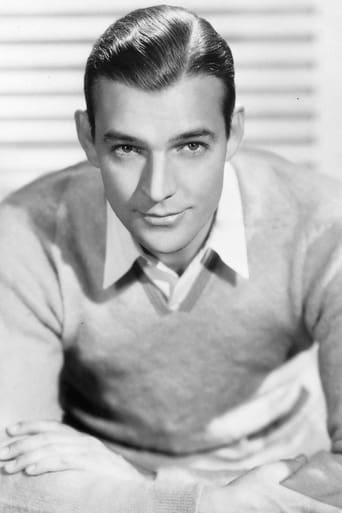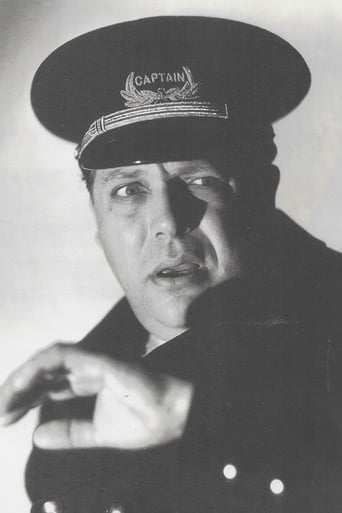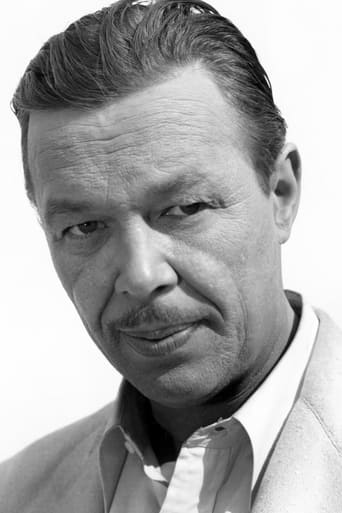PiraBit
if their story seems completely bonkers, almost like a feverish work of fiction, you ain't heard nothing yet.
Donald Seymour
This is one of the best movies I’ve seen in a very long time. You have to go and see this on the big screen.
Erica Derrick
By the time the dramatic fireworks start popping off, each one feels earned.
classicsoncall
It's always cool to come across an unexpected treat as I did today, looking for a film to view from my collection of 'B' Westerns put out by Mill Creek Entertainment. This one co-starred baseball legend Lou Gehrig along side singing cowboy Smith Ballew, and it was a genuinely fun picture to watch. Gehrig plays himself, heading West to Montana to relax on his sister's cattle ranch. I'm curious how baseball/movie fans of the era reacted when he pronounced early in the picture - "Take it or leave it, I'm through with baseball" - must have been a shock to the system! The plot Gehrig finds himself in is a fairly typical one though. The local Ranchers Protective Association is being run by stand in boss Ed Saunders (Arthur Loft), and he's forcing the locals to join his organization as he and his henchmen take a hefty cut of the rancher profits for themselves. The Gehrig's see no need to join, and when Saunders turns up the heat, they hook up with attorney Larry Kimball (Ballew) who's been anxious to take up the fight against the bad guys with a client willing to go the distance.This is the first film I've seen with Smith Ballew, though I'm familiar with his reputation. A popular singer in the Thirties, he appeared in a number of Westerns doing just that, crooning as a singing cowboy. One of the oft repeated trivia notes attributed to Ballew is that he dubbed John Wayne's singing voice in "Riders of Destiny", but Ballew denied that repeatedly before he died. Wayne's recollection was that it was probably Bill Bradbury (brother of Bob Steele and son of director Robert North Bradbury), who did the singing, with money earned to support his college education.Speaking of John Wayne, it struck me more than once that Gehrig might have shared a passing resemblance to the star, maybe more of a cross between Wayne and another veteran cowboy actor, Tim McCoy. Which is to say that he looked right at home in Western gear and ten gallon hat. Gehrig's portrayal is somewhat self deprecating, as he gets thrown from a horse in the early going, but when things get really wild, he reverts to his baseball wits. In a rousing bar room brawl, Gehrig winds up with a few billiard balls to knock out a bunch of bad guys. Later on, he manages to smash an upper story window of Saunders' office using a bat and ball. I thought only Babe Ruth called his shots like that.It wouldn't have been an era Western without your traditional horse chase scenes, and on that score, it was unusual to see some of the local businessmen in suits high tail it out of town on horseback. Of course, the team of Gehrig and Ballew, with a little help from sister Peggy (Evalyn Knapp), defeat the bad guys and save the day. Gehrig's earlier 'retirement' from baseball comes to an end when he gets a telegram from the Yankees saying that they met his terms. So Gehrig's movie career began and ended with this picture, but while it lasted, it must have been a blast.
John W Chance
Lou Gehrig was one of American major league baseball's greatest players. Check out his statistics on the Internet. His farewell speech at Yankee Stadium, given two years before his death to what we now call "Lou Gehrig's Disease" (ALS), was ranked the Number One Moment in Sports by fans during the 2008 All-Star Game. He wasn't just one of the baseball immortals, but unlike Ty Cobb or Babe Ruth, he had an extremely winning personality. For any fan of baseball, we are lucky to see that personality preserved for posterity in this film.The movie is really a Smith Ballew (who?) Western. Although Ballew starred in eleven Westerns, he was originally a band leader and jazz singer of the twenties and thirties (discovered by Tommy Dorsey no less!) He became one of the first singing cowboys; therefore, this one has a lot of singing. We get two 'comic' cowboy songs sung by him, one of which has the famous pop singer of the forties, Buddy Clark, singing for Lou Gehrig. Ballew's spotlighted ballad, "Driftin'," was written by Albert von Tilzer, composer of "Take Me Out to the Ballgame," and "I'll Be With You in Appple Blossom Time." Beside this fine number, we get a country swing band doing a short version of "That Old Washboard Band," written and performed by Willie and Norman Phelps, who also do "Texas Washboard Rag" (which they also wrote) in Tex Ritter's 'Hittin' the Trail' (1937). For those who may not know, the washboard, augmented with copper pots and a bicycle horn, was a staple of Western movie bands. It was Spike Jones in the forties who elevated the augmented washboard to orchestral instrument status.Other credits for this film are equally impressive. Ray Taylor, who directed so many famous serials was the director. Among his many outstanding serials are 'The Return of Chandu' (1934), 'Flash Gordon,' (1936), 'Flash Gordon Conquers the Universe' (1940) and 'The Perils of Pauline' (1933), which starred Evalyn Knapp, who is featured in this movie as the heroine, though she gets little to do here. 'The Perils of Pauline' is especially noteworthy because it appears to take place at locations all over the world. In this movie we also get Dick Curtis, veteran of over 230 movies and TV shows (mostly as a villain), the ever present Lafe McKee, and the plump Cy Kendall as the dishonest sheriff.Then there's Lou Gehrig himself. Unlike other athletes who appeared in films, he is neither wooden, unemotional or out of place. One reviewer here described him as 'almost giddy' in his performance. I think, however, we have him in all his naturalness as a person, playing the role of a cowboy, with his smiling, dimpled, good natured sincerity. We see him throw billiard balls in a bar fight, and smash a window with a rock hit by a bat. He was left handed! He certainly does get a little giddy when he is called back for spring training at the end.The film's story is promising. In Rawhide, Montana, Saunders, an evil businessman, (in these thirties depression era movies what other kind is there?) is running a protection racket, forcing all the ranchers to join the "Ranchers' Protective Association," or face the consequences. Good natured Lou, going to live on his sister's ranch to find "peace and quiet," gets thrown into the middle of this conflict. With only the good town lawyer (Smith Ballew) to help him, Lou finds the odds heavily stacked against him in his defiance of the evil Saunders, and early attempts to circumvent Saunders' power and control are met with failure.Is the film fun to watch? Yes. We get some snappy dialog like, "You boys are carrying things with a pretty high hat," and "If you lie down with dogs, you get up with fleas." When Lou first sees his new home in Montana, he jubilates, "Boy! What a Ritz!" When Smith tells Lou that if he's going to stand up against Saunders, he'll have to stick it through, Lou replies enthusiastically, " Why I'm Old Man Stick It Through myself!" Prophetic, but true to Lou Gehrig's nature.Unfortunately, the defeat of the racketeers and the resolution of the conflict are too quickly and easily handled. After Smith rouses all the ranchers against him (in a fast forty seconds), Saunders declares "We've got to get out of town!" and the final horseback chase sequence takes place. Just like that. Smith's knockout punch to Saunders, and we're off to the happy ending. The rapid resolution detracts from the impact of the story's development, and weakens the film considerably.Still, I have to give it a five and a half for its other wonderful elements, especially preserving Lou Gehrig's enthusiastic presence.
Michael_Elliott
RAWHIDE (1938) ** (out of four) After finishing the baseball season, the real Lou Gehrig travels to Montana to visit his sister where he learns an evil banker is stealing all of their land. This really isn't a good movie but it's quite fun seeing the baseball legend act. I wouldn't say he gave a good performance but it's worth watching either way. I'm not sure if Gehrig was acting or just playing himself but he's always got a smile on his face, which is quite charming considering the pain he must have been feeling at the time. There really isn't too much footage out there of Gehrig so this film, warts and all, is pretty important.
bkoganbing
I noticed in the credits of Rawhide before the film started it listed that Lou Gehrig was appearing in the film due to the arrangement of Christy Walsh. Walsh was Gehrig's business manager, he got Gehrig as a client through his team mate Babe Ruth whose business affairs Walsh also managed. I guess this western was another money making project for Gehrig to do off season. In fact the film begins with Lou in New York's Grand Central Station telling reporters he's off to live with his sister who has a ranch in Montana and if likes it he's through with baseball.Not exactly being a trained thespian, Lou played the only role he could have played, Lou Gehrig. When he arrives in Montana, Lou discovers his sister is being squeezed by the Cattleman's Association which in that neck of the woods is nothing more than a protection racket. In fact he's got the best line in the film when he tells the bad guys that hearing their operation and how it works he has a feeling he's back in New York right now. Lou and sister Evalyn Knapp get a lawyer to fight them. But not just any lawyer, a singing cowboy lawyer in the person of Smith Ballew. Between the three of them, the villains are of course routed.In real life Lou Gehrig was an only child and in real life he did go to spring training with the Yankees in 1939. But it was his last one because that disease that bears his name was starting to take its toll. In fact during the second half of the 1938 season and the World Series against the Cubs, Lou's statistics fell off dramatically. As a western star, Lou Gehrig would not have given John Wayne any concern about a rivalry. But I would point out that in the film the Jackie Robinson Story where Jackie played himself, he was plainly ill at ease in front of the camera. And that was a project dreamed up by Branch Rickey who was running the Dodgers at the time.Rawhide is a curiosity and certainly would have been long forgotten, but for the presence of a sports legend.




